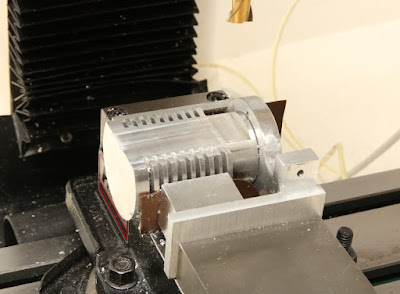When I got the fins cut off.
There are two operations left before I take this off the table and start on the next part. First is to cut an opening in that side (that's facing up), centered 1/2" in from the left end, 1/4" wide and 3/4" long. At the shallowest (in the center), it's about .060 deep; at the ends of the cut the metal is .230 thick. Still, it shouldn't be terribly hard. Maybe drill three 1/4" holes and mill out the web that's left between the drill holes. The second operation is to cut heat sink fins in that pristine left end of the cylinder. This will be done with a 3/32" thick slitting saw purchased for this reason. Those follow the same pattern as the fins on the rest of the cylinder, fin and space are both 3/32 wide with 3/16 from the edge of one fin to the next. The fins are also 3/16 deep, while the others were 1/4" deep. 3/16, or 0.188" steps will be getting a lot of use.
Neither of those operations seems particularly scary, but while I've used a thin slitting saw blade on my light duty Sherline mill dozens of times, I've never used one on the big machine and never to do something like this. Take It Easy will be the mode of the day, and not an Eagles song.


You clearly have skills, my friend.
ReplyDeleteYou do beautiful work.
ReplyDeleteSiG, Nice job!
ReplyDeleteDry run the program for the slitting saw off to the left of the
part. Try adding -2. inchs or so to the X zero position. Make sure the lead in and lead out clear the diameter of the saw and the z position is where you want it. You can then adjust the X to just cut .002-.003 witness lines on the face of the part. This way you will know you have the saw set in the Z axis as well. Dry run is a great way of making sure all is well before you commit. More than once I've had the saw retract and skive off a corner or break the saw. Good luck. Email me if you like.
Now I can uncross my fingers.
ReplyDeleteThat looks amazing.